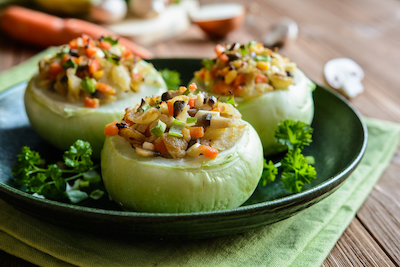Spotlight on Kohlrabi
Why don’t more people grow kohlrabi? I mean, what’s not to like? It’s easy to grow, it’s tasty in a multitude of recipes, it comes in beautiful colors, and it’s one of the most unusual-looking vegetables you’ll ever find. And kohlrabi isn’t in your garden because … ?
Here’s the deal on kohlrabi. As a member of the Brassica family (Brassica oleracea, to be exact), it is a cousin of broccoli, cauliflower, cabbage and kale.
Kohlrabi is found in shades of white, green and purple, and several interesting cultivars are available. ‘Korridor’ is an eye-catching white variety, ‘Winner’ is an excellent green specimen, and ‘Purple Vienna’ is an exquisite purple.
For best results, plant seeds in full sun, ¼- to ½-inch deep, spaced 3 to 6 inches apart in rows 12 inches apart. You can start seeds indoors, but kohlrabi is a hardy plant and you can direct-sow outdoors in spring before your last frost date. Choose a location with well-drained soil and keep your plants regularly watered.

While it handles cool temperatures, it doesn’t do well with cold or freezing temperatures. A light frost will sometimes improve the flavor of kohlrabi, but the plants tend to bolt if exposed to freezing temps. You can plant kohlrabi successively throughout the summer to extend your harvest.
Harvest the bulbs when they reach about 2 inches in diameter—usually in 45 to 60 days. You can leave them to grow larger (up to 4 or 5 inches) but the texture tends to be better when they’re harvested at a smaller size. The exception? Giant varieties, like Kossak, can reach 8 inches in diameter while still maintaining good flavor and texture.
Kohlrabi in the Kitchen
Once you’ve harvested your kohlrabi, get ready for a treat! Many people compare its flavor to a sweet cabbage or turnips, but some think it tastes more like broccoli or radishes. The greens and bulbs are edible and can be eaten raw or cooked.
For fresh use in salads, you’ll want to harvest young, tender greens, but if you’re harvesting greens later in the season when they’re not as tender, you’ll probably prefer them cooked. You can prepare greens in the same manner as mustard greens or collard greens—sautéed, steamed or stir-fried.
Kohlrabi bulbs are versatile and taste great raw or cooked. Many people opt to peel the bulbs, then thinly slice them and serve them in salads or alongside a flavorful dip. Raw kohlrabi is also a popular choice in slaws, perhaps because its flavor is reminiscent of cabbage.
I think roasting improves pretty much any vegetable, and kohlrabi is no exception, especially when you roast it along with root vegetables like potatoes, onions and carrots. Or just roast the kohlrabi by itself—it doesn’t necessarily need a sidekick.
You can sauté, steam or stir-fry the kohlrabi bulbs and then incorporate them into an array of dishes, especially those paired with cheese—and particularly goat cheese, yum! Kohlrabi makes an out-of-the-ordinary pizza topping, too.
Then there’s soup! Hungarian kohlrabi soup holds a special place in Hungarian cuisine. Known as karalábéleves, it’s a flavorsome combination of onions, carrots, chicken stock, parsley and sometimes bacon.
There are so many ways to use this underestimated vegetable, you’ll want to grow it in your vegetable garden this season.
This article by Samantha Johnson originally appeared in the September/October 2019 issue of Northern Gardener. Northern Wisconsin-based Samantha Johnson is the author of several books, including The Beginner’s Guide to Vegetable Gardening, (Voyageur Press, 2013).
